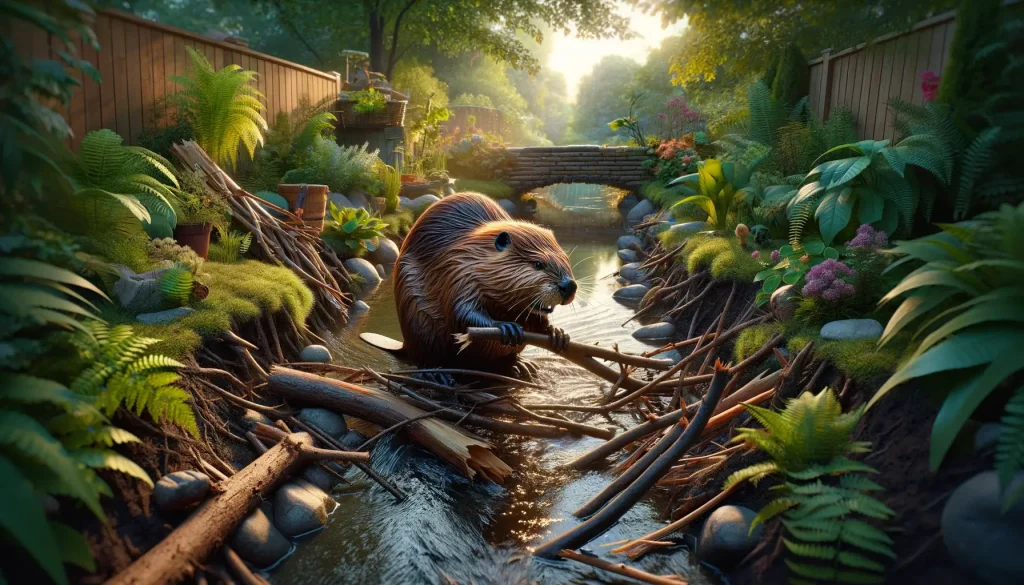
Why Backyard Beavers Build Dams
Encountering a beaver in your backyard can be a surprising, yet fascinating experience. From the mysterious felling of trees to the creation of complex dams, a beaver’s behavior is a testament to their role as natural engineers. Recently, a beaver made its presence known in my backyard by skillfully taking down a tree, an activity spotted against the comical backdrop of my Bullmastiff, Petunia, looking on. This incident brought to life stories of a beaver family settling in the stream behind my house, sparking curiosity about these intriguing creatures and their lifestyle.
Beavers are not only among the largest rodents in the world, but they also lead a nocturnal and semi-aquatic life. Weighing anywhere from 26-60 pounds, and sometimes reaching up to 100 pounds, these animals lead intricate lives, forming close-knit family units. The observed tree-felling could be linked to the season, as January marks the peak of beaver mating season. It raises questions about the reasons behind their building efforts and how they sustain their vegetarian diet through different seasons.
Is it just natural instinct or is there more to the beaver’s dam-building behavior? Let’s dive deeper into understanding the fascinating world of backyard beavers.
FAQs on Backyard Beaver
When it comes to exotic pets or backyard wildlife, beavers definitely spark a lot of interest and questions. Here’s a quick FAQ to shed light on some of the most common queries about these fascinating creatures.
How big do beavers get?
Beavers are one of the heftiest rodents out there. Adult beavers can weigh anywhere from 26-60 pounds, though some giants in the wild have tipped the scales at around 100 pounds.
What do beavers eat?
These animals are strict vegetarians. Their diet mainly consists of bark, leaves, twigs, and plant roots. They’re known for their unique property of creating food caches for the winter, storing small logs and green branches in the mud of the stream near their lodges.
Why do beavers build dams?
Beavers build dams primarily to create deep, still water to protect against predators and to increase their access to food during the winter. The water behind a dam may not fully freeze, allowing beavers access to underwater food caches. The largest beaver dam recorded, located in Alberta, Canada, extends over half a mile in length.
Are beavers social animals?
Yes, beavers are quite social and live in close-knit family units which typically include two adults (that pair for life), their kits, and sometimes yearlings from the previous season. A beaver family can consist of 4-8 members.
How do beavers affect their environment?
Beavers are natural engineers. Their dam-building activities can significantly alter the landscape, creating wetlands that provide habitat for a wide range of wildlife. While they can sometimes conflict with human activities by flooding roads or cutting down trees in backyards, their environmental impact is largely positive, enhancing biodiversity and water quality.


Backyard Beaver Babies’ Early Life
Beaver kits are a testament to the wonder of nature. Born fully furred and with their eyes open, these babies are ready to take on the world from day one. Entering the world in the safe confines of their lodge, beaver kits are the heart of beaver families, usually consisting of 4-8 members.
The parental pair, which mates for life, shares the responsibility of raising their young, alongside their yearlings from previous seasons. This family structure emphasizes the social nature of beavers, showcasing a nurturing environment where kits can thrive.
From the moment they are born, beaver kits are introduced to a vegetarian diet. Bark, leaves, twigs, and plant roots are all part of the menu. This diet is essential not just for their immediate nutritional needs but also teaches them the vital skills of foraging and food storage for the colder months. Adults educate their kits on constructing food caches in autumn, a critical survival strategy. These caches are stashes of small logs and green branches buried in the mud of the stream near their lodge, ensuring a food supply during winter when the water surface freezes over.
The construction of these lodges and the nurturing of kits within them are cornerstone activities for beaver families. Whether the lodge is a pile of mud, logs, sticks, or a cozy burrow dug into the stream bank, it serves as a safe haven for the newborn kits. Here, they grow and learn under the watchful eyes of their parents and older siblings.
Nature’s Beaver Dentistry
Beaver teeth never stop growing. This fact might sound troublesome, but for beavers, it’s a crucial part of their lifestyle. Their teeth are naturally self-sharpening, thanks to the iron-rich enamel that gives them an orange tint. This natural mechanism is essential as their primary activities, including gnawing on trees and building dams, could otherwise wear their teeth down quickly.
To manage their ever-growing teeth, beavers constantly chew on wood. This process not only helps in construction projects but also keeps their teeth at a manageable length. The iron in their enamel not only hardens their teeth but makes them uniquely capable of dealing with tough materials. It’s a perfect example of how nature equips its creatures for survival.
Another fascinating aspect of beaver teeth is their role in determining the health and well-being of these animals. Researchers can examine the growth layers in a beaver’s teeth, much like reading tree rings, to estimate the age and health status of individuals. This method provides valuable insights into the life history of beavers living in the wild.
Beaver Coats for Warmth
Beaver fur is remarkable, offering more than just an attractive coat. This luxurious fur serves crucial survival functions, especially in the cold environments these animals often inhabit. Understanding the dual-layered design of a beaver’s coat can shed light on how they stay warm and active, even in icy waters.
The outer layer of a beaver’s coat is made of long, coarse guard hairs. These hairs repel water, helping keep the beaver dry when swimming. Underneath, there’s a dense, soft underfur. This layer traps air and provides incredible insulation. Together, these layers keep a beaver warm and buoyant while swimming in cold water.
Beavers also produce a special oil, spread through their fur with the help of their “grooming claws” on their hind feet. This oil further waterproofs their coat, ensuring that they remain dry even when submerged. It’s a testament to the ingenuity of nature, equipping these animals with a built-in wetsuit of sorts.

Living with Backyard Beavers
Having a beaver or a family of beavers as backyard neighbors is not just a unique experience but also an educational one. Observing these creatures in your own space brings insight into their behavior, their impact on the environment, and how humans can coexist with them. Here’s what you need to understand if you find yourself sharing your backyard with beavers.
Beaver activities, such as the tree felling observed in my backyard, are not acts of random destruction. Instead, these actions are part of their natural behaviors, critical for their survival. Whether it’s dam building in the stream that runs through your yard or chewing off limbs from trees, every action has a purpose, from creating a safe habitat to ensuring a stable food supply.
Understanding the beaver diet is crucial. As strict vegetarians, they rely on a diet of bark, leaves, twigs, and plant roots. This diet supports their substantial body size and provides the energy needed for their extensive construction projects. Homeowners might notice beavers targeting specific trees or shrubs, which can be mitigated by protecting valuable plants with wire mesh or similar barriers.
The construction of beaver dams is often the most visible sign of beavers in the area. These dams serve several purposes, from creating deep water to protect against predators to maintaining access to food during the winter. While fascinating to observe, beaver dams can pose challenges for property owners, including potential flooding. In such cases, consulting with wildlife professionals who can offer non-lethal management options is best.
Social structure is key to beaver life. The close-knit family units demonstrate a complex social system, where each member plays a role in the group’s survival. Understanding this can increase appreciation for their presence and reduce the likelihood of viewing them solely as pests.
Conservation status and legal protections vary by location but knowing the status of beavers in your area is essential. While they are not currently endangered, their activities can sometimes conflict with human interests, leading to negative outcomes for the beavers. Advocating for humane solutions and habitat conservation is important for their protection.
Finally, remember that observing beavers up close is a privilege, offering a unique glimpse into the natural world. These encounters can foster a greater appreciation for wildlife and the complexities of their existence. If you have stories or questions about backyard beavers, sharing them can contribute to a broader understanding and coexistence between humans and these remarkable animals.

Beavers at Work
Spotting a beaver at work in your backyard is a clear sign you’re living close to nature. The experience of watching these critters fell trees and build dams is not just intriguing; it’s educational. My Bullmastiff, Petunia, seemed just as curious when we observed a beaver busily detaching limbs from a recently felled tree. This activity, especially noted during January’s mating season, opens up a world of questions and fascination with these skilled animals.
Adult beavers, being large nocturnal and semiaquatic rodents, weigh significant amounts, up to 100 pounds. Their ability to impact their environment is tremendous. Observing them in action reveals the complexity of their behaviors and the reasons behind them. For instance, the felling of trees isn’t a random act of deforestation but a calculated effort towards secure lodging and food supply.
The creation of food caches is a prime example of their forward-thinking. As strict vegetarians, beavers need a stable food source through the winter months. They prepare by stockpiling small logs and green branches in mud near their lodges. This behavior underscores their survival strategies and emphasizes the need to understand, rather than immediately mitigate, their actions in our backyards.
The distinguished beaver dam, often a monumental feature in streams and rivers, serves multiple crucial purposes. It provides safety from predators, sustains food access during frosty winters, and even helps in creating wetland ecosystems beneficial for other species. The engineering prowess of beavers showcases their fundamental role in ecological balance and biodiversity.
Living alongside these creatures can indeed pose challenges, like potential flooding from dam construction. Yet, understanding their behavior indicates these are not mere nuisances but rather actions deeply rooted in instinct and survival. It teaches us about cohabitation and the importance of each species in maintaining ecological harmony.
Beginner Guide to Raising Quail at Home
What are the Signs of a Dog Concussion?
What Causes Your Dog’s Ears to Smell Bad?
When your dog’s ears start to emit an unpleasant odor, it might leave you puzzled…
Methimazole Treatment for Cat Hyperthyroidism
Methimazole plays a crucial role in managing feline hyperthyroidism, a condition marked by an overactive…
Got Hummingbirds in your Backyard? Here’s How to Care for Them.
Why Does Your Cat Pee Outside the Litter Box?
Cat’s Litter Box Issues It’s not uncommon for cat owners to face the frustrating dilemma…




